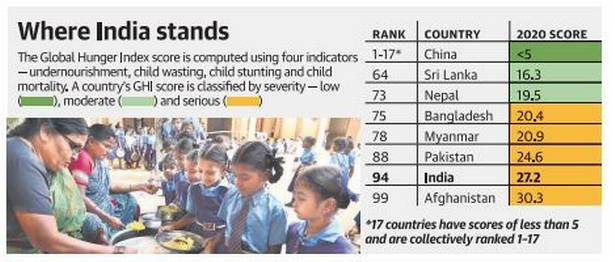Social Justice
Global Hunger Index 2020
- 17 Oct 2020
- 7 min read
Why in News
India has been ranked at 94 among 107 countries in the Global Hunger Index (GHI) 2020.
Global Hunger Index
- Annual Report: Jointly published by Concern Worldwide and Welthungerhilfe.
- It was first produced in 2006. It is published every October. The 2020 edition marks the 15th edition of the GHI.
- Aim: To comprehensively measure and track hunger at the global, regional, and country levels.
- Calculation: The GHI scores are calculated each year to assess progress and setbacks in combating hunger. It is calculated on the basis of four indicators:
- Undernourishment: Share of the population with insufficient caloric intake.
- Child Wasting: Share of children under age five who have low weight for their height, reflecting acute undernutrition.
- Child Stunting: Share of children under age five who have low height for their age, reflecting chronic undernutrition.
- Child Mortality: The mortality rate of children under the age of five.
- Scoring:
- Based on the values of the four indicators, the GHI determines hunger on a 100-point scale where 0 is the best possible score (no hunger) and 100 is the worst.
- Each country’s GHI score is classified by severity, from low to extremely alarming.
Key Points
- Global Scenario:
- Worldwide Hunger: Represented by a GHI score of 18.2 (moderate level), down from a 2000 GHI score of 28.2 (serious).
- Factors:
- The Covid-19 pandemic and the resulting economic downturn, as well as a massive outbreak of desert locusts in the Horn of Africa and other crises, are exacerbating food and nutrition insecurity for millions of people.
- It needs to be noted that 2020 GHI scores do not reflect the impact of Covid-19 on hunger and undernutrition.
- The above mentioned crises come on top of existing hunger caused by conflict, climate extremes, and economic shocks (random, unpredictable events).
- The Covid-19 pandemic and the resulting economic downturn, as well as a massive outbreak of desert locusts in the Horn of Africa and other crises, are exacerbating food and nutrition insecurity for millions of people.
- Region-wise Performance: Africa South of the Sahara and South Asia have the highest hunger and undernutrition levels among world regions, with 2020 GHI scores of 27.8 and 26.0, respectively—both considered serious.
- SDG 2 Progress: The world is not on track to achieve the second Sustainable Development Goal - known as Zero Hunger for short - by 2030.
- Indian Scenario:
- Overall Performance:
- With a score of 27.2, India has a level of hunger that is “serious”.
- It ranks 94 out of 107 countries in the Index. In 2019, India’s rank was 102 out of 117 countries.
- Comparison with Other Countries:
- India features behind Nepal (73), Pakistan (88), Bangladesh (75), Indonesia (70) among others.
- Out of the total 107 countries, only 13 countries fare worse than India including countries like Rwanda (97), Nigeria (98), Afghanistan (99), Liberia (102), Mozambique (103), Chad (107) among others.
- Performance on the Indicators:
- Undernourishment: 14% of India’s population is undernourished (2017-19). It was 16.3% during 2011-13.
- Child Wasting: 17.3% (2015-19), it was 15.1% in 2010-14.
- Child Stunting: 34.7%, it has improved significantly, from 54% in 2000 to less than 35% now.
- Child Mortality: 3.7%, it was 5.2% in 2012.
- Overall Performance:
Some Related Initiatives by India
- Eat Right India Movement: An outreach activity organised by the Food Safety and Standards Authority of India (FSSAI) for citizens to nudge them towards eating right.
- POSHAN Abhiyaan: Launched by the Ministry of Women and Child Development in 2018, it targets to reduce stunting, undernutrition, anemia (among young children, women and adolescent girls).
- Pradhan Mantri Matru Vandana Yojana: A centrally sponsored scheme executed by the Ministry of Women and Child Development, is a maternity benefit programme being implemented in all districts of the country with effect from 1st January, 2017.
- Food Fortification: Food Fortification or Food Enrichment is the addition of key vitamins and minerals such as iron, iodine, zinc, Vitamin A & D to staple foods such as rice, milk and salt to improve their nutritional content.
- National Food Security Act, 2013: The National Food Security Act, (NFSA) 2013 legally entitled up to 75% of the rural population and 50% of the urban population to receive subsidized food grains under the Targeted Public Distribution System.
- Mission Indradhanush: It targets children under 2 years of age and pregnant women for immunization against 12 Vaccine-Preventable Diseases (VPD).
- Integrated Child Development Services (ICDS) Scheme: Launched on 2nd October, 1975, the Integrated Child Development Services (ICDS) Scheme offers a package of six services (Supplementary Nutrition, Pre-school non-formal education, Nutrition & health education, Immunization, Health check-up and Referral services) to children in the age group of 0-6 years, pregnant women and lactating mothers.
Suggestions
- Governments, private actors, and NGOs should carefully coordinate their responses to overlapping food and health crises and work with community organizations to make sure interventions are culturally acceptable, reach the most vulnerable, and preserve local ecosystems.
- Food should be priced not only by its weight or volume but also by its nutrient density, its freedom from contamination, and its contribution to ecosystem services and social justice.
- Governments should expand access to maternal and child health care, as well as education on healthy diets and child feeding practices.
- Supporting smallholder farmers in becoming sustainable and diversified producers; governments and NGOs must seek to improve those farmers’ access to agricultural inputs and extension services, coupling local and indigenous agricultural knowledge with new technologies.
- Existing human rights-based multilateral mechanisms and international standards—such as the Committee on World Food Security—must be strengthened to support inclusive policy making and sustainable food systems.





